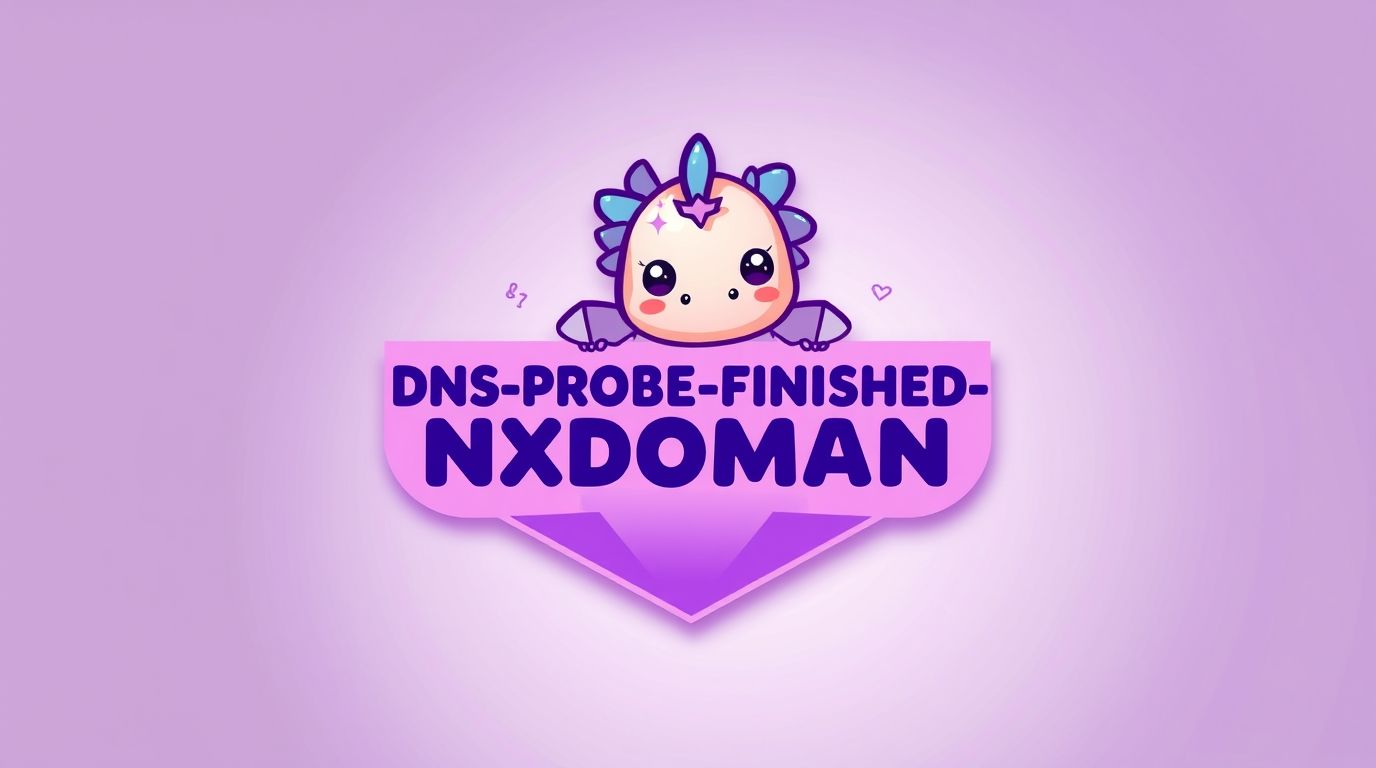
How to Clear or Flush DNS Cache on Chrome Using chrome://net-internals/#dns in 2025
Introduction
Are you experiencing website connectivity issues, incorrect website redirects, or slow loading times in Google Chrome? The culprit might be outdated or corrupted DNS cache entries. Google Chrome maintains its own internal DNS caching system to improve browsing performance, but sometimes these cached entries can become stale, leading to various browsing problems that affect your online experience.
In this comprehensive guide, we'll walk you through the exact process of using chrome://net-internals/#dns to clear or flush your DNS cache in Chrome. This essential troubleshooting technique can resolve many common browsing issues and should be in every Chrome user's toolkit. Whether you're a web developer, IT professional, or everyday internet user, knowing how to properly manage Chrome's DNS cache can save you hours of frustration and keep your browsing experience smooth and efficient.
What is DNS Cache and Why Should You Clear It?
Understanding DNS Cache in Chrome
DNS (Domain Name System) cache is a temporary database maintained by your browser that stores information about recent visits to websites. When you type a domain name (like spidyhost.com) into your browser, Chrome first checks its internal DNS cache to find the corresponding IP address before making a request to external DNS servers.
This caching mechanism serves several important purposes:
- Improved Performance: By storing DNS lookups locally, Chrome reduces the time needed to resolve domain names you frequently visit
- Reduced Network Traffic: Fewer DNS queries travel across the internet, reducing bandwidth usage
- Continued Accessibility: If your DNS server temporarily goes down, you can still access recently visited sites using cached information
Google Chrome's DNS caching is separate from your operating system's DNS cache, meaning you might need to clear both in certain troubleshooting scenarios.
Why DNS Cache Needs Regular Clearing
There are several situations where flushing your Chrome DNS cache using chrome://net-internals/#dns becomes necessary:
- Website IP Changes: When a website has recently migrated to a new server with a different IP address
- Persistent Connectivity Issues: If you're unable to access certain websites that you know are online
- Incorrect Redirects: When you're being directed to incorrect or outdated website versions
- DNS Poisoning Concerns: After removing malware that might have corrupted DNS entries
- Website Development: When testing changes to DNS settings for websites you're developing
- Network Troubleshooting: As a general troubleshooting step for resolving internet connectivity problems
- Privacy Considerations: To remove traces of websites you've visited from your browser's cache
Not clearing your DNS cache when necessary can lead to frustrating browsing experiences, including inability to access updated websites, security vulnerabilities, and slower browsing speeds.
How to Clear DNS Cache in Google Chrome: Detailed Step-by-Step Guide
Method 1: Using chrome://net-internals/#dns (Primary Method)
- Open Google Chrome on your computer (Windows, macOS, or Linux)
- Type the following URL in the address bar:
chrome://net-internals/#dns - Press Enter to navigate to Chrome's internal network settings page
- Locate the "Clear host cache" button in the upper right section of the page
- Click on the button to instantly flush Chrome's DNS cache
- Verify the process (Chrome doesn't show a confirmation message, but the cache is cleared immediately)

The chrome://net-internals/#dns page provides not only the ability to clear your DNS cache but also displays information about Chrome's network status and connection details. The interface is designed for technical users but clearing the cache is straightforward with the clearly labeled button.
Method 2: Clearing Socket Pools for Complete Refresh
For a more thorough DNS flush, you should also clear the socket pools, which manage Chrome's network connections:
- Open a new Chrome tab
- Enter the following URL in the address bar:
chrome://net-internals/#sockets - Review the current socket information displayed on the page
- Click on the "Flush socket pools" button
- Close the tab or continue browsing with refreshed network connections

Socket pools are collections of pre-established network connections that Chrome maintains to improve connection speeds to frequently accessed servers. Flushing these pools forces Chrome to establish new connections, which can resolve issues related to stale connection data.
Method 3: Using the Chrome Omnibox Quick Command
For users who prefer shortcuts, Chrome offers a quick way to access network internals:
- Type
chrome://netin the address bar - Press Enter, and Chrome will redirect you to the Net Internals page
- Click on the "DNS" tab in the left sidebar
- Use the "Clear host cache" button as described in Method 1
This approach is slightly faster than typing the full chrome://net-internals/#dns URL and provides the same functionality.
Method 4: Using Chrome Developer Tools for Advanced Users
For more advanced users, Chrome Developer Tools offers another way to manage DNS cache:
- Open Chrome Developer Tools by pressing F12 or right-clicking on a page and selecting "Inspect"
- Navigate to the Network tab in the Developer Tools panel
- Check the "Disable cache" option at the top of the panel
- Keep Developer Tools open while browsing to prevent Chrome from using cached DNS entries
- Reload the page with Ctrl+R (Windows/Linux) or Cmd+R (macOS) to fetch fresh DNS information
This method is particularly useful for web developers who need to test DNS changes without repeatedly clearing the cache manually.
Verifying if DNS Cache Has Been Successfully Flushed
After clearing your DNS cache in Chrome using chrome://net-internals/#dns, it's important to verify that the operation was successful. Here are multiple verification methods:
Using Chrome's DNS Internals Page
- Navigate to
chrome://net-internals/#dns - Look at the "Host Resolver Cache" section
- Verify that entries for problematic domains are no longer present
Using Command Prompt/Terminal for Technical Verification
On Windows:
- Open Command Prompt (cmd.exe)
- Type
ipconfig /displaydns | findstr "example.com"(replace example.com with the domain you're checking) - If no entries appear for Chrome's cache, the flush was successful
On macOS:
- Open Terminal
- Type
sudo dscacheutil -flushcache; sudo killall -HUP mDNSResponderto flush system DNS - Type
dig example.comand check the "ANSWER SECTION" for fresh DNS information
On Linux:
- Open Terminal
- Type
dig example.combefore and after clearing Chrome's cache - Compare the output to see if resolved IP addresses have changed
Practical Verification Method
A simpler way to verify is by:
- Load a website that was previously having issues
- Open Chrome Developer Tools (F12)
- Go to the Network tab
- Look at the DNS resolution time for the domain
- Check if the problems are resolved (proper page loading, correct content displayed)
If a previously problematic website now loads correctly, it's a good indication that clearing the DNS cache has resolved the issue.
When to Clear DNS Cache at Different Levels
Chrome-Level DNS Cache Using chrome://net-internals/#dns
Chrome's internal DNS cache should be your first troubleshooting step when experiencing:
- Issues specific to Chrome but not other browsers
- Problems after Chrome updates
- Selective website access problems
System-Level DNS Cache
If clearing Chrome's cache doesn't resolve the issue, the problem might be at the operating system level. Here's how to clear the DNS cache in different operating systems:
Windows:
ipconfig /flushdns
After running this command, you should see: "Successfully flushed the DNS Resolver Cache."
macOS:
sudo dscacheutil -flushcache
sudo killall -HUP mDNSResponder
macOS doesn't provide confirmation, but these commands clear the system DNS cache.
Linux (Ubuntu/Debian):
sudo systemd-resolve --flush-caches
or
sudo service network-manager restart
For other Linux distributions, the command may vary based on the DNS resolver in use.
Router-Level DNS Cache
Some advanced routers also maintain DNS caches. Consider these steps if problems persist:
- Access your router's admin panel (typically at 192.168.0.1 or 192.168.1.1)
- Look for DNS settings in the configuration options
- Clear DNS cache if the option is available
- Alternatively, reboot your router to clear all temporary caches
ISP-Level DNS Cache
In rare cases, the issue might be with your Internet Service Provider's DNS cache:
- Consider switching to alternative DNS servers temporarily:
- Google DNS: 8.8.8.8 and 8.8.4.4
- Cloudflare DNS: 1.1.1.1 and 1.0.0.1
- Contact your ISP's technical support if issues persist with multiple devices and browsers
Advanced DNS Cache Management in Chrome
Using Chrome Flags for DNS Configuration
Chrome offers experimental features that can be enabled through chrome://flags:
- Navigate to
chrome://flags - Search for "dns" in the search box
- Look for options like "Async DNS resolver" or "DNS over HTTPS"
- Modify settings based on your specific needs
- Restart Chrome for changes to take effect
Understanding Chrome's DNS Prefetching
Chrome uses DNS prefetching to speed up browsing by resolving domain names before you click on links:
- Navigate to
chrome://settings/security - Find "Use a prediction service to load pages more quickly"
- Toggle this setting if you want to disable DNS prefetching
Disabling prefetching can help isolate DNS issues but may slightly reduce browsing performance.
Comprehensive DNS Troubleshooting Guide
| Issue | Symptoms | Possible Cause | Solution |
|---|---|---|---|
| Cannot access specific websites | "This site can't be reached" errors | Outdated DNS cache entries | Clear Chrome DNS cache using chrome://net-internals/#dns |
| Websites loading with old content | Outdated information displayed | Stale DNS and HTTP cache | Clear DNS cache and browsing data |
| Slow initial page loads | Long "Resolving host" status in browser | Inefficient DNS resolution | Try alternative DNS servers and clear cache |
| Security warnings | "Your connection is not private" errors | Compromised DNS settings | Clear cache, scan for malware, check SSL certificates |
| Intermittent connectivity | Random website access failures | DNS server issues | Switch to a more reliable DNS provider, clear cache regularly |
| Redirects to incorrect sites | Being sent to unexpected websites | DNS poisoning or hijacking | Clear all cache levels, run security scan, check HOSTS file |
| Wrong IP resolution | Website connects to incorrect server | Outdated DNS cache after migration | Use chrome://net-internals/#dns to clear Chrome's cache |
Optimizing Chrome's DNS Performance Beyond Clearing Cache
After clearing your DNS cache using chrome://net-internals/#dns, consider these additional steps to enhance Chrome's DNS performance:
Enable DNS-over-HTTPS (DoH)
- Go to
chrome://settings/security - Look for "Use secure DNS"
- Enable the option and select a provider
- Benefit from encrypted DNS queries for improved privacy and security
Install DNS-Related Chrome Extensions
Consider these useful extensions for DNS management:
- DNS Benchmark: Test and identify the fastest DNS servers for your location
- HTTPS Everywhere: Force secure connections where available
- WebRTC Network Limiter: Prevent WebRTC from leaking your actual IP address
Optimize Chrome's Connection Settings
- Navigate to
chrome://net-internals/#sockets - Review current limit settings
- Navigate to
chrome://flags - Search for "socket" to find connection-related experimental features
- Adjust settings based on your network environment

Frequently Asked Questions About chrome://net-internals/#dns
How often should I clear my Chrome DNS cache?
You typically only need to clear your Chrome DNS cache when experiencing connectivity issues. There's no need to do it regularly as part of maintenance unless you're a web developer testing DNS changes or particularly concerned about privacy.
Will clearing DNS cache using chrome://net-internals/#dns delete my browsing history or passwords?
No, clearing the DNS cache only removes the stored IP address mappings for websites. It won't affect your browsing history, saved passwords, cookies, or other personal data. DNS cache is strictly related to domain name resolution.
Why does Chrome have its own DNS cache separate from my operating system?
Google Chrome maintains its own DNS cache to improve browsing performance by reducing the time needed to look up website addresses that you visit frequently. This browser-level caching gives Chrome more control over network performance optimization independent of the operating system's cache.
Can I disable Chrome's DNS caching completely?
While there's no direct setting to disable DNS caching in Chrome permanently, you can:
- Use Chrome with the
--dns-prefetch-disablecommand-line flag - Keep Developer Tools open with "Disable cache" checked
- Use Incognito mode, which limits cache persistence
Does clearing DNS cache work the same way in all Chrome versions?
The basic process using chrome://net-internals/#dns works in all recent versions of Chrome (version 48 and above), but the exact appearance of the interface may vary slightly between versions. In older versions, you might need to navigate through different tabs in the Net Internals page.
How is chrome://net-internals/#dns different from other Chrome internal pages?
The chrome://net-internals/#dns page is specifically focused on DNS management, while other internal pages like:
chrome://net-internals/#events- Shows network eventschrome://net-internals/#proxy- Displays proxy settingschrome://net-internals/#sockets- Shows socket connectionschrome://net-internals/#http2- Displays HTTP/2 connection information
Each serves different network troubleshooting purposes.
Can clearing the DNS cache fix security issues?
Clearing the DNS cache can help resolve certain security issues related to DNS spoofing or poisoning, where attackers redirect traffic to malicious sites. However, it's not a comprehensive security solution and should be combined with anti-malware scans and proper security practices.
Does chrome://net-internals/#dns work on Chrome for Android or iOS?
The chrome://net-internals/#dns interface is primarily available on desktop versions of Chrome (Windows, macOS, Linux). Mobile versions of Chrome have limited access to internal pages, though DNS cache clearing may still occur through the standard cache clearing process in settings.
Conclusion: Mastering Chrome DNS Cache Management
Clearing your Chrome DNS cache using chrome://net-internals/#dns is a powerful troubleshooting technique that can resolve many connectivity issues. By following the steps outlined in this comprehensive guide, you can:
- Resolve website access problems caused by outdated DNS entries
- Improve browsing performance by ensuring fresh DNS resolutions
- Enhance online security by clearing potentially compromised DNS records
- Troubleshoot network issues more effectively with proper cache management
Remember that DNS issues can occur at different levels of your network stack, so if clearing Chrome's cache doesn't solve your problem, consider clearing your system's DNS cache or contacting your network administrator for further assistance.
The chrome://net-internals/#dns tool is just one of many powerful features hidden within Chrome's internal pages. Taking the time to familiarize yourself with these tools can significantly enhance your browsing experience and troubleshooting capabilities.
For more advanced web hosting and networking tips, explore our other guides on SpidyHost.com, where we provide comprehensive solutions for all your web hosting needs.
Last Updated: March 2025
DevOps Engg
A metallurgist by education, tech enthusiast by passion. I've transformed my curiosity into expertise in web hosting, DevOps, and web development. With hands-on experience in Linux administration, cPanel, WordPress, and Node.js.
View more posts by Shaik Vahid


![100 Essential Linux Commands: The Ultimate Guide [2025]](https://cms.spidyhost.com/uploads/Linux_Commands_6e748148b8.jpg)
